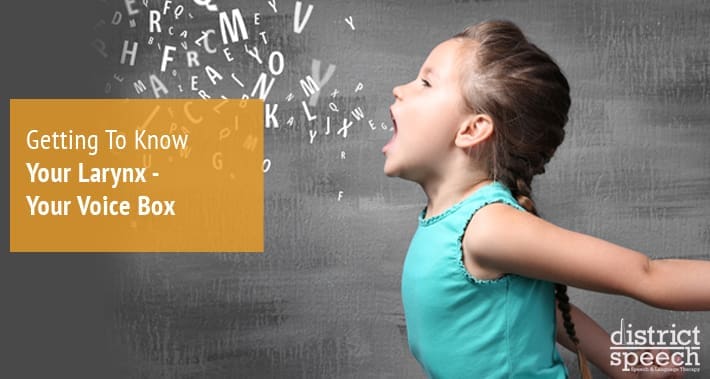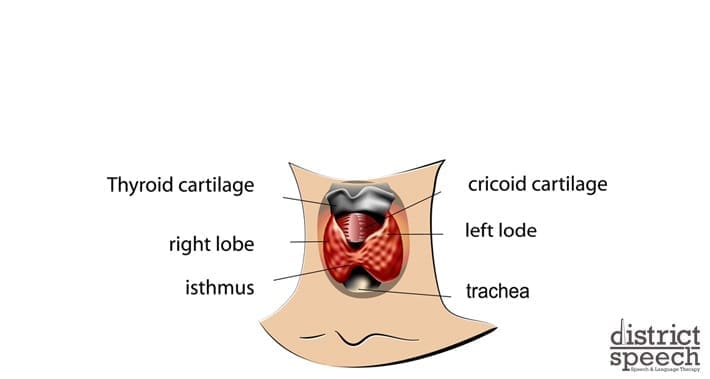
You might have heard of the larynx, or your voice box.
But you might not know what exactly it does, or how it works.
This article will help you understand the role of your larynx and why it’s important.
It’s a vital part of speech, and something you could have your speech therapist look at if you think something’s off.
We can do a lot more than help with conditions like tongue thrust or teach you how to reduce your drooling.
If you’re looking for speech therapy in Washington, we’re here to help you learn more about your voice and achieve your speech goals.
Keep reading to find out more.
What Is Your Larynx?
Along with your vocal folds, your larynx is part of the vibratory system, which is one of the three subsystems that allow you to speak and sing.
The other two subsystems are the air pressure system and the resonating system.
The larynx causes your vocal cords to vibrate, changing air pressure to sound waves.
This produces voiced sound, which is what you can hear.
Your larynx is one of the areas where your voice can resonate from, which contributes your resonance.
This is something you can learn to control with your speech therapist, and can be an area of focus if you are looking for transgender voice training for trans women.
It also allows you to perform several vital functions, such as breathing, swallowing food, and coughing.
If you’re having trouble swallowing food, it could be a symptom of dysarthria.
The larynx does this by opening and closing your glottis, which is the space between the two vocal folds, at the right moments.
When you breathe, the larynx opens the glottis by parting the vocal folds, but more on those later in this article.
When you swallow food, the larynx closes your glottis.
This mechanism prevents you from choking, as the vocal folds are brought to the center.
When you get the urge to cough, it’s your larynx that closes the glottis and then opens it so you can expel air as you cough.
When speak, your larynx closes your glottis and adjusts vocal fold tension, which allows your vocal folds to vibrate during speaking and singing.
If you put your hand to your throat while speaking, you can feel this vibration for yourself.
Adjusting the vocal fold tension also allows change the pitch of your voice, as well as its volume.
Laryngitis, or swelling of your larynx, is the most common issue affecting your larynx and voice.
What Are The Parts Of Your Larynx?
The larynx is comprised of several smaller parts, which are the cartilages, muscles, nerves, and vocal folds.
Each one has a distinct function within the vibratory system.
Keep reading to learn more about each of them.

Cartilages
There are three cartilages within the larynx: the thyroid cartilage, the cricoid cartilage, and the arytenoid cartilages, which are left and right cartilages.
The thyroid cartilage makes up the front part of the larynx.
It protects your thyroid, a small endocrine gland in the front of your throat.
The front most part of the thyroid cartilage is also known as your Adam’s apple.
Despite its name, women have an Adam’s apple as well.
Shall we call that the Eve’s apple, then?
Anyway, your thyroid cartilage is also where your vocal cords are located, just below the Adam’ s apple.
The cricoid cartilage is located below the thyroid cartilage and has a ring like, front to back structure.
It becomes taller at the back of your larynx and serves as a platform for the arytenoid cartilages.
The arytenoid cartilages are a pair of small, pyramid shaped cartilages.
They connect with the cricoid cartilage at the back of your vocal folds.
The arytenoid cartilages and the cricoid cartilage form the cricoarytenoid joint.
Muscles
In addition to the cartilages, your larynx also has several muscles, which are named for the cartilages they’re attached to.
The thyroarytenoid muscle, lateral cricoarytenoid muscle (R and L muscles), and the inter-arytenoid muscle (transverse and oblique) help to position your vocal folds in the midline when you’re speaking.
These muscles are what scientists pay attention to when studying the effects of vocal training.
Recent studies have suggested that vocal training improves your neuromuscular efficiency, but does not significantly grow your thyroarytenoid muscle.
This is important because as you age, you are more likely to experience muscle loss in your larynx, which can contribute to a vocal impairment.
Improving your neuromuscular efficiency with speech therapy can help.
Now, back to the final larynx muscle: the posterior cricoarytenoid muscle moves the vocal folds apart and opens the glottis.
It is attached to cricoid and arytenoid cartilages and also plays a role in breathing.
The vocalis muscle, which is derived from inner and deeper fibers of thyroarytenoid muscle, adjusts the length and tension of the vocal folds.
It also alters vocal fold tension and relaxation during speaking or singing and is important in voice production.
The cricothyroid muscle is attached to cricoid and thyroid cartilages and tilts the thyroid cartilage, which increases the tension of vocal folds.
The cricothyroid muscle plays a role in high-pitched singing and in the pitch glide of singing.
These are the muscles that a child with childhood apraxia of speech has trouble sending signals from their brain to.
Nerves
There are several nerves that send signals through the muscles of the larynx.
All the muscles except the cricothyroid muscle receive input from the recurrent laryngeal nerve (RLN), whereas the cricothyroid muscle receives input from the superior laryngeal nerve (SLN).
The RLN takes its name from the fact that it travels down the left side of the body into the chest, and comes back up (recurs) into the neck, ending at the larynx.
The RLN has a long path and a short path.
The long path of the RLN is a circuit that goes through the chest.
The short path of the RLN continues in the upper chest and loops around the right subclavian artery, just behind the clavicle (collarbone), then travels the short distance in the neck to the larynx.
Vocal Folds
The larynx houses your left and right vocal folds.
The vocal folds include three distinct layers that work together to produce vocal fold vibration.
The covering, or mucosa, is a loose structure that is key to vocal fold vibration during sound production.
The epithelium, basement membrane, and superficial lamina propria (SLP) all make up the mucosa.
The vocal ligament includes the thyroarytenoid muscle.
This muscle helps close the glottis and regulate tension of the vocal folds during speaking and singing.
Controlling the vibrational speed of your vocal folds is controlling the pitch of your voice while singing or speaking.
The medial portion of this muscle is also called the vocalis muscle, which is itself composed of the intermediate lamina propria and the deep lamina propria.
The deep lamina propria contains collagen fibers that are stronger and more rigid than the superficial lamina propria.
Book Your Appointment With District Speech Today
If you have questions about your larynx or are concerned that it might not be functioning the way it’s supposed to, District Speech can help.
Your larynx makes up part of your aerodigestive tract, and if you have an aerodigestive disorder you may have an issue with it.
Book an appointment with us today and you’ll have the opportunity to meet with one of our licensed speech pathologists.
At your appointment, you’ll have the opportunity to tell your speech therapist about your speech challenges and needs.
At District speech, we work closely with both adults and children, so we can come up with a plan to help you reach your speech goals no matter your age.
Book your appointment with District Speech today.
1300 I St NW, Suite 400 E,
Washington, DC 20005
- https://g.page/districtspeech
District Speech and Language Therapy specializes in speech therapy, physical therapy, and occupational therapy solutions, for both children and adults, in the Washington D.C and the Arlington Virginia areas.